Did you know that speech recognition and voice recognition are two separate technologies? People often make the common mistake of misinterpreting one technology with another. Both technologies share some technical background and are developed to boost convenience and improve efficiency. In reality, they are distinct.
Both technologies have their working procedure and different sets of applications. Hence, in this blog, we will learn about speech and voice recognition and comprehend what makes them different. So let us begin!
What Does Speech Recognition Mean?
Speech recognition is a technology that enables a software program to recognize human speech, understand it, and further translate it into text. The process for speech recognition is implemented using machine learning and Natural Language Processing (NLP). Usually, speech recognition programs are evaluated using two parameters:
Speed: It is examined by analyzing the time duration for which the software can keep up with a human speaker.
Accuracy: It is determined by identifying the percentage of errors while converting spoken words into digital data.
Speech recognition is a common software program used in healthcare, businesses, and several other organizations.
How Does Speech Recognition Work?
Speech recognition is an evolving technology that has progressed significantly over the years. It is far better than its initial versions and exhibits high accuracy.
Speech recognition technology essentially relies upon the concept of ‘feature analysis.’ In this method, the voice input is processed using the phonetic unit recognition method, which identifies the similarities between the actual voice input and expected inputs.
This is done to achieve more accurate results. However, achieving complete accuracy in speech recognition is near to impossible due to differences and inflections of accents and speeches in different people.
Let us now understand how speech recognition works:
- The microphone records and translates the vibrations of the speaker’s voice into an electrical signal.
- The signal is further converted into a digital signal using a computer system.
- The digital signal is sent to a preprocessing unit that improves the speech signal and mitigates noise.
- Next, an acoustic model analyzes the input signal and registers phonemes and other parts of the speech to distinguish one word from another.
- The phonemes are then formulated into comprehensible words and sentences, leveraging language modeling.
[Also Read: Custom TTS Solutions for Your Unique Requirements]
What Does Voice Recognition Mean?
Voice recognition is a technology used to determine a speaker’s identity and attribute each instance of the speech to the correct speaker. Unlike speech technology, which focuses on what the user says, the voice recognition system focuses on who the speaker is. Essentially, speech recognition works by analyzing the different speech aspects of different individuals.
How Does Voice Recognition Work?
Voice recognition leverages template matching, where a recorded voice sample is matched against a user’s voice. Before the software is used with a user, the software must be trained to recognize a user’s voice.
Here is how the process works:
- Fore mostly, the voice recognition software is trained by enabling a speaker to repeat a phrase several times on a microphone.
- In the next step, the software computes a statistical average of samples of similar words or phrases.
- Finally, after analyzing sufficient data, the software stores the average sample of the word or phrase as a template in its database.
Notably, voice recognition offers better accuracy than speech recognition.


